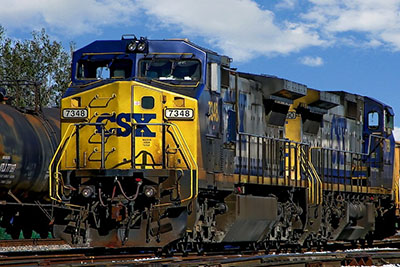CSX provides update on Southeastern U.S. intermodal service

Earlier this month, Class I railroad carrier CSX said that it had made various changes for its intermodal freight offerings into and out of several southeastern-based United States facilities.
CSX spokesperson Rob Doolittle told LM that these changes are the result of market conditions, customer demand and CSX’s transition to its new operating model known as Precision Scheduled Railroading (PSR). PSR is a cornerstone of the ongoing implementation of CSX’s operating plan by its President and CEO E. Hunter Harrison, which he deployed in previous top executive positions at both CP and CN. Precision railroading requires cargo to be ready when rail cars arrive for loading or risk being left behind.
“CSX will continue providing reliable intermodal freight-rail connectivity among markets across our network, as we strive to maintain or improve transit times for customers and operate as efficiently as possible,” said Doolittle.
Effective October 23, CSX said it will continue to provide service on more than 110 lanes between Fort Pierce, Jacksonville, Miami, Tampa and Winter Haven, Fla.; Fairburn and Savannah, Ga.; Charleston, S.C.; Memphis, Tenn. and destinations across the United States.
CSX’s Doolittle added that these facilities will continue to receive freight through more than 165 lanes, originating in locations such as Baltimore, Chicago, Cincinnati, Denver, Los Angeles, Memphis, Northwest Ohio, Philadelphia, Pittsburgh and Worcester Mass.
And it also has announced changes to service into and out of Columbus, Ohio, and Detroit. Service from those locations continues to markets such as Baltimore, Jacksonville, Kearney (N.J.), Miami, Philadelphia, Portsmouth (Va.), Worcester and western-state destinations and origins.
Information about these changes has been communicated directly to customers and other affected shareholders, Doolittle explained, adding that “Customers with questions are encouraged to contact their CSX service representatives or visit www.intermodal.com, where they will find a variety of information sources and tools to use in addressing their intermodal freight transportation needs.”
An October 13 report in Trains magazine stated that CSX is getting ready to scale back operations at its North Baltimore, Ohio-based intermodal hub. This $175 million facility has been in operation since 2011. The report said that the terminal’s sorting days are numbered, due to CSX’s move to PSR.
When this hub first opened, CSX said it was the cornerstone of a new double-stack freight rail corridor between East Coast sea ports such as the Port of Baltimore and the Midwest, adding that it employs more than 200 full-time employees, and would serve as the transfer point for hundreds of thousands of freight containers annually.
And this facility is part of CSX’s National Gateway project, whose mission is to provide greater capacity for product shipments in and out of the Midwest, reduce truck traffic on congested highways, as well as create thousands of jobs that will directly or indirectly support the National Gateway. The National Gateway focuses on three existing rail corridors that run through Maryland, Virginia, North Carolina, Pennsylvania, Ohio, and West Virginia: the I-70/I-76 Corridor between Washington, D.C. and northwest Ohio via Pittsburgh; the I-95 Corridor between North Carolina and Baltimore via Washington, D.C.; and the Carolina Corridor between Wilmington and Charlotte, North Carolina.
CSX has received a fair amount of attention in recent weeks related to service issues experienced over the summer as a result of switching to the PSR operating model.
As previously reported, these things included informal complaints from both CSX customers and railroad industry stakeholders in regards to various service issues, including: transit times increasing significantly and/or becoming unpredictable; loaded and empty railcars sitting for days at yards; switching operations becoming inconsistent and unreliable; car routings becoming circuitous and inefficient; CSX customer service being unable to provide meaningful assistance; and slowing train speed and increasing dwell time along with numbers of cars online. These issues were cited in a late July letter to Harrison from STB leadership, including STB Acting Chairman Ann Begeman, former STB Vice Chairman Daniel Elliott, and Board Member Deb Miller.
On this week’s CSX third quarter earnings call, Harrison drove home how these issues are on well on their way to being a thing of the past, which should be viewed as encouraging by railroad shipper customers.
“I think that we went through obviously some slippage service-wise in the third quarter, which we're not proud of,” Harrison said on the call. “I've been in this business a long time, and this company is back to where it was; it's back to where it was, and it's better, and it's climbing, and I see those issues, generally speaking, behind us, which I'm very proud of that. It reflects to some degree the resiliency of this organization, to go through what this organization has been through, and to be able to come out of an eight-nine-week, a little setback.”
Harrison was quick to defend his long-established and highly successful PSR model, too, explaining that these service issues did not represent the model being a failure as it is an operating plan that's been in existence for more than 20 years with an excellent track record.

Article Topics
News & Resources
Latest in Materials Handling
Registration open for Pack Expo International 2024 Walmart chooses Swisslog AS/RS and software for third milk processing facility NetLogistik partners with Vuzix subsidiary Moviynt to offer mobility solutions for warehouses Materials Handling Robotics: The new world of heterogeneous robotic integration BSLBATT is looking for new distributors and resellers worldwide Lucas Watson appointed CSO for Körber’s Parcel Logistics business in North America Hyster recognizes Dealers of Distinction for 2023 More Materials HandlingAbout the Author
Subscribe to Materials Handling Magazine

Find out what the world's most innovative companies are doing to improve productivity in their plants and distribution centers.
Start your FREE subscription today.
April 2024 Modern Materials Handling

Latest Resources










